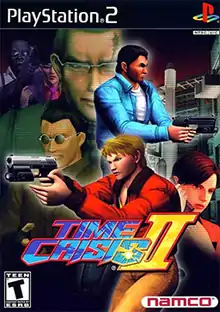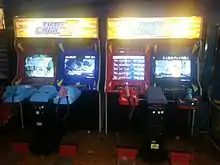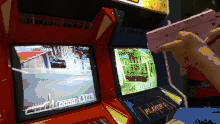Time Crisis II
Time Crisis II is a light gun arcade game, developed and released by Namco in December 1997, and is the second installment in the Time Crisis series. The game incorporates the same mechanics of its predecessor, with some minor changes, but with the addition of co-operative two-player gaming. The game's story focuses on the efforts of two secret agents, Keith Martin and Robert Baxter, as they attempt to thwart the efforts of a industry mogul's plan for world dominance.
| Time Crisis II | |
|---|---|
 North American cover art | |
| Developer(s) | Namco |
| Publisher(s) | Namco |
| Producer(s) | Takashi Sano |
| Platform(s) | Arcade, PlayStation 2 |
| Release | ArcadePlayStation 2
|
| Genre(s) | Rail shooter |
| Mode(s) | Single-player, multiplayer |
| Arcade system | Namco System 23, Super Namco System 23 |
The game was ported to the PlayStation 2 in October 2001, as part of a bundle to coincide with the launch of the GunCon 2 controller (G-Con 2 in Europe), with enhanced graphics, though ports for the original PlayStation and Dreamcast were cancelled during development.[2] The game received mostly favorable review for the arcade version, but mixed feedback on the console version. A sequel to the game, Time Crisis 3, was released in 2002.
Gameplay


Time Crisis II was released utilizing Namco's System 23 arcade board in 1997, and was ported to PlayStation 2 (with enhanced graphics and polygon textures) in 2001. The game utilizes the foot pedal system, just like Time Crisis, where players can shoot or hide from enemy fire. One modification to the hide and attack system was the "crisis flash" system which alerts the players whether or not the enemy's attack would cause a direct hit, a feature not present in its first predecessor, Time Crisis. When pressing down on the pedal, the player comes out of hiding, being able to shoot the enemies. Releasing the pedal puts the player behind cover to avoid critical bullets and reload the weapon, though the player cannot shoot whilst hiding. Certain sections of the game give players a machine gun with unlimited ammo.
The player loses a life if hit by a critical bullet or an obstacle and the game ends when the player loses all lives. Players also lose a life if the time limit (which is replenished after each area is cleared) drops to zero (unlike the first game where running out of time resulted in a game over). Players can continue from the point their current position, as opposed to the PlayStation version of Time Crisis, which required players to restart from the beginning of a section.
This was the first Time Crisis game to introduce two-player cooperative play by allowing two people to play simultaneously, allowing each player to cover the other (in single player, the computer controls the other character). The arcade version used connecting cabinets, allowing a player to allow another player to join, or to exclusively play alone. The PlayStation 2 version features split-screen or System Link functionality, which requires two televisions, consoles, and copies of the game and an iLink cable to use. Points are deducted for shooting the other player, though neither player will lose lives as a result. The same system is utilized once again in for events Time Crisis 3 and Time Crisis 4.
Plot
In 1997, NeoDyne Industries announces it plan to launch a series of 64 satellites, codenamed the "StarLine Network", that will help to unify the world's communication networks. However, V.S.S.E. agent Christy Ryan discovers that the company's CEO, Ernesto Diaz, plans to launch an experimental nuclear satellite into space and sell it to the highest bidder. Escaping to a safehouse with a suitcase of incriminating data, she quickly finds herself tracked down and captured by NeoDyne mercenaries, led by Jakov Kinisky, moments before V.S.S.E. agents Keith Martin and Robert Baxter arrive to collect her. While Christy is taken to Diaz, Kinisky flees with the suitcase, forcing the agents to pursue him. After killing him during a boat chase, the pair retrieve the case and learn that the experimental satellite is being transported via train.
Locating the train, Keith and Robert board it, and attempt to destroy, but are thwarted by NeoDyne's mercenaries and security, who manage to extract the satellite. Learning that Diaz is preparing to launch the satellite from a remote spaceport, the pair travel to the site, encountering further resistance led by Wild Dog - a former crimeboss that was defeated by the V.S.S.E. but whose body was never found. Both agents quickly are forced into a firefight with Dog, who keeps them at bay with a prosthetic mini-gun that replaced his right arm and additional assistance, but is defeated. Before he can be forced to surrender, he commit suicide with explosives, leaving the agents to focus on the satellite.
After rescuing Christy from Diaz, Keith and Robert focus on Diaz, who initiates the launch sequence before activating the defense system of a prototype satellite to engage them. With precious few seconds on the clock, Keith and Robert destroy the prototype, sending Diaz falling to his death. Without him to finish the sequence, the rocket malfunctions and explodes. Robert and Keith are plucked out of the water by Christy and then extracted by the V.S.S.E. just as the rest of the spaceport goes up in flames.
PlayStation 2 port
The PlayStation 2 version of the game featured enhanced graphics and additional cutscenes. It was packaged with the GunCon 2 lightgun peripheral, although it was also compatible with the Original Guncon. When completed enough times, the player could unlock alternative weapons, such as a machine gun or shotgun, and had the option of wielding two lightguns at a time (with combinations of both GunCon 2 and original GunCon possible). There is also a Crisis Mission mode, in which the players have to complete and perform various tasks, including a simulated gun duel against Richard Miller, the lead protagonist of the first Time Crisis game. Extras also included a clay pigeon shooting mode (including a port of Namco's Shoot Away II light gun clay shooting arcade game), and a virtual port of the mechanical arcade game, Quick & Crash.
Reception
| Aggregator | Score |
|---|---|
| Metacritic | 81/100[3] |
| Publication | Score |
|---|---|
| AllGame | |
| Edge | 6/10[5] |
| EGM | 7.5/10[6] |
| Eurogamer | 7/10[7] |
| Famitsu | 32/40[8] |
| Game Informer | 8.25/10[9] |
| GamePro | |
| GameRevolution | B[11] |
| GameSpot | 7.2/10[12] |
| GameSpy | 80%[13] |
| GameZone | 8/10[14] |
| IGN | 8.7/10[15] |
| Next Generation | (arcade) (PS2) |
| OPM (US) | |
| Maxim | 8/10[19] |
In Japan, Game Machine listed Time Crisis II on their June 15, 1998 issue as being the second most-successful dedicated arcade game of the year.[20]
The game was met with positive reviews upon release. Edge gave the arcade version the award for 1998 Coin-Op of the Year, above Sega Rally 2 and Get Bass. Edge described Time Crisis II's "separate-screen" two-player mode as "one of the most convincing forms of cooperative play ever seen in the arcade."[21] AllGame gave it a score of four-and-a-half stars out of five.[22]
Next Generation reviewed the arcade version and commented: "Not as big a milestone as the first, but definitely a superb game from Namco."[16] They were less enthusiastic about the PlayStation 2 conversion, saying that while it was "great for what it is", wasn't as good as other lightgun shooters.[17]
The PlayStation 2 version received "favorable" reviews according to the review aggregation website Metacritic.[3] In Japan, Famitsu gave it and the Gun Con 2 bundle a score of 32 out of 40.[8]
References
- Quartermann (December 1997). "Video Game Gossip & Speculation". Electronic Gaming Monthly. No. 101. Ziff Davis. p. 40.
Time Crisis 2 is due to hit Japanese arcades this Christmas and February in the U.S.
- "Time Crisis II (Dreamcast)". IGN.
- "Time Crisis II Critic Reviews for PlayStation 2". Metacritic. Retrieved 19 February 2014.
- Frankle, Gavin. "Time Crisis II (PS2) - Review". AllGame. Archived from the original on 14 November 2014. Retrieved 29 December 2016.
- Edge staff (December 2001). "Time Crisis II (PS2)". Edge (104).
- EGM Staff (October 2001). "Time Crisis II (PS2)". Electronic Gaming Monthly (148): 146.
- Bramwell, Tom (13 November 2001). "Time Crisis II Review". Eurogamer. Retrieved 19 February 2014.
- "プレイステーション2 - タイムクライシス2 +ガンコン2(同梱版)". Famitsu. 915: 66. 30 June 2006.
- Leeper, Justin (October 2001). "Time Crisis 2". Game Informer (102). Archived from the original on 8 February 2005. Retrieved 19 February 2014.
- Air Hendrix (2 October 2001). "Time Crisis 2 Review for PS2 on GamePro.com". GamePro. Archived from the original on 7 February 2005. Retrieved 19 February 2014.
- G-Wok (October 2001). "Time Crisis II Review (PS2)". Game Revolution. Retrieved 19 February 2014.
- Davis, Ryan (4 October 2001). "Time Crisis II Review". GameSpot. Retrieved 19 February 2014.
- Thornton, Benjamin (10 October 2001). "Time Crisis II". PlanetPS2. Archived from the original on 4 August 2004. Retrieved 19 February 2014.
- The Badger (27 November 2001). "Time Crisis 2 with Guncon Review - PlayStation 2". GameZone. Archived from the original on 22 March 2009. Retrieved 19 February 2014.
- Perry, Douglass C. (2 October 2001). "Time Crisis II". IGN. Retrieved 19 February 2014.
- "Finals". Next Generation. No. 43. Imagine Media. July 1998. p. 120.
- Lundrigan, Jeff (October 2001). "Finals". Next Generation. Vol. 4 no. 10. Imagine Media. p. 77.
- "Time Crisis II". Official U.S. PlayStation Magazine: 134. October 2001.
- Boyce, Ryan (4 September 2001). "Time Crisis 2". Maxim. Archived from the original on 7 March 2014. Retrieved 14 November 2014.
- "Game Machine's Best Hit Games 25 - 完成品夕イプのTVゲーム機 (Dedicated Videos)". Game Machine (in Japanese). No. 566. Amusement Press, Inc. 15 June 1998. p. 21.
- "File:Edge UK 067.pdf - Retro CDN". retrocdn.net.
- Weiss, Brett Alan. "Time Crisis II (ARC) - Review". AllGame. Archived from the original on 14 November 2014. Retrieved 29 December 2016.